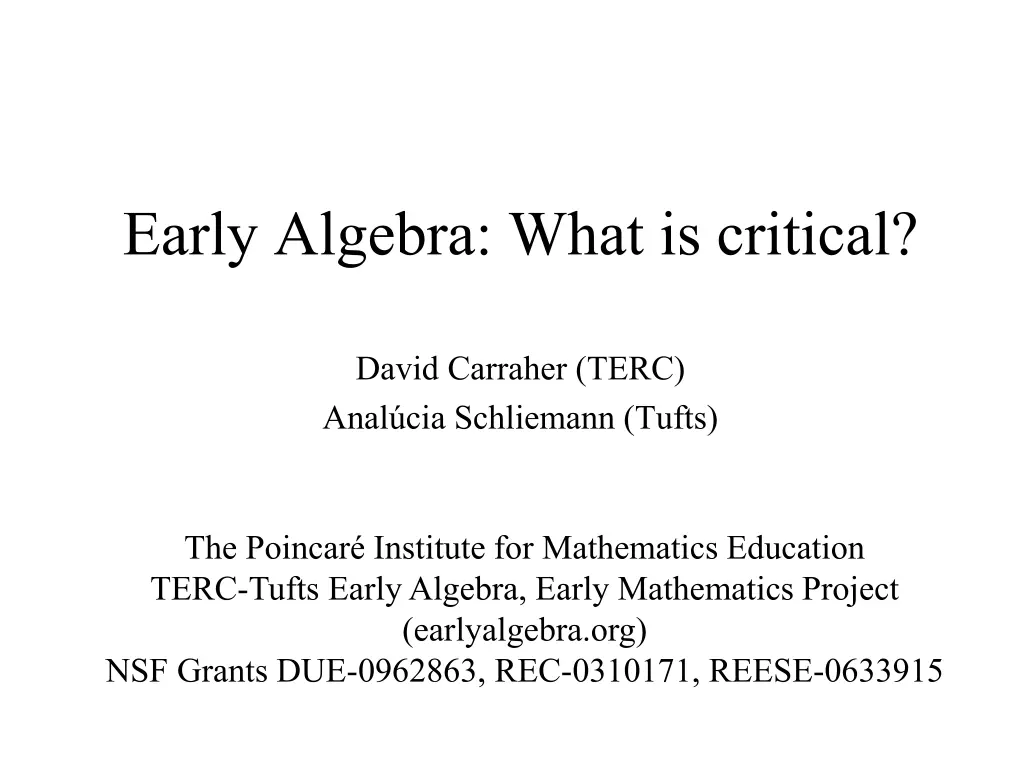
Understanding Early Algebra Concepts
Explore the importance of introducing functions and variables in early algebra education to enhance students' understanding of mathematical concepts. Discover the balance between discovery and direct instruction to foster critical thinking skills.
Download Presentation

Please find below an Image/Link to download the presentation.
The content on the website is provided AS IS for your information and personal use only. It may not be sold, licensed, or shared on other websites without obtaining consent from the author. If you encounter any issues during the download, it is possible that the publisher has removed the file from their server.
You are allowed to download the files provided on this website for personal or commercial use, subject to the condition that they are used lawfully. All files are the property of their respective owners.
The content on the website is provided AS IS for your information and personal use only. It may not be sold, licensed, or shared on other websites without obtaining consent from the author.
E N D
Presentation Transcript
Early Algebra: What is critical? David Carraher (TERC) Anal cia Schliemann (Tufts) The Poincar Institute for Mathematics Education TERC-Tufts Early Algebra, Early Mathematics Project (earlyalgebra.org) NSF Grants DUE-0962863, REC-0310171, REESE-0633915
Exclusive focus on Arithmetic leads to: Equals sign as unidirectional operator. Focus on particular answers (unknowns, not variables). Inability to represent verbal statements as equations. Manipulation of equations as procedural rules.
A Functions-Approach to Early Algebra: Arithmetic as part of a broader field of studies arithmetic operations as functions Emphasis on variables and relations between sets of possible cases instead of isolated computation results. Multiple representations: function tables, graphs, algebraic notation, verbal statements. Gradual shift from semantics to syntax.
But, can young students truly (be expected to) understand functions and variables covariation equations graphs algebraic notation?
In a nutshell 1. Not on their own, but yes, with certain varieties of instruction 2. Not unless we distinguish minor topics and issues major, overarching concepts such as functions.
Not on their own Striking a balance between discovery and direct instruction, students representations and conventional representations Students have intuitions, their own representations, and prior understanding that are critical But students will not re-invent conventional representational systems (number systems, algebraic notation, number lines, graphs...)
The Cart and the Horse In Mathematics, Axioms, definitions, precise formulations, and proofs often lead; insight and understanding follow. In early and middle school Mathematics Education, axioms, definitions, and so forth always follow students own intuitions, interpretations, and representations
An Example from Research Mathematical representations: f(x) := x +8 g(x) := 3x x + 8 = 3x
The Study Longitudinal classroom intervention (grades 3 to 5) with follow up data collection (grades 7 and 8). Two cohorts of 26 and 24 children in two classrooms. Comparison to control peers. Boston Public School serving minority groups and immigrant families. Regular curriculum plus early algebra activities for three hours per week. Analysis of videotaped discussions and written assessment data.
The Wallet Problem Three lessons - beginning of 2nd semester in grade 4 Mike has $8 in his hand. The rest of his money is in his wallet. Robin has exactly three times as much money as Mike has in his wallet. What can you say about the amounts of money that Mike and Robin have?
Day 1 Students initial discussion and spontaneous representations of the problem.
Day 3 Predicting graphs from tabular data y-intercept Rate of change, slope Intersection of two graphs Using the geometric information to draw inferences about the stories .
W + 8 3W
Evidence students worked with variables, relations and functions: 1. Amount in Mike s wallet construed as a variable (not merely as isolated particular values). 2. They flexibly moved between graphical, tabular, and narrative accounts. 3. They organized the outcomes according to intervals of the independent variable. ( up to $3.99, at $4.00, from $4.01 upward). 4. Explicitly referred to rates of change.
Three years later: Written Assessment Results in grades 7 and 8
Average percent of correct answers on items related to the 3rd to 5th grade intervention lessons (old items).
Average percent of correct answers on items related to the summer camp lessons (new items).
Results by the control and experimental groups on items related to summer camp lessons (new items), before and after participation in Summer Camp 2009.
What is critical? Create situations in classrooms in which values are allowed to vary Equations have variables, but we usually do not allow them to vary. I.e. we treat them as single-valued unknowns. If we treat equations as the comparison of functions, letters stand for variables, not single-valued unknowns.






















